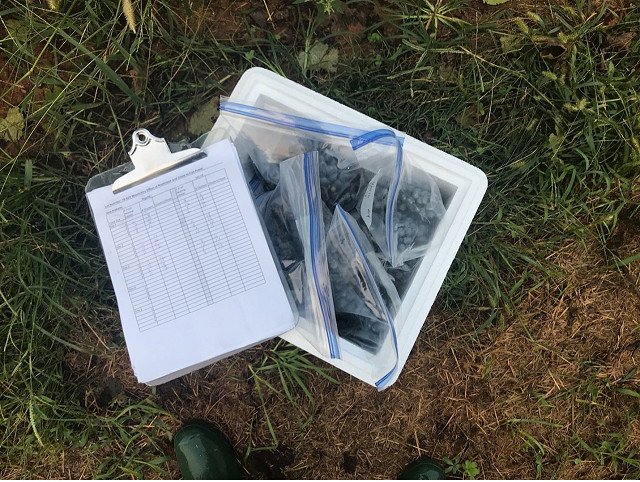Hello Dear Readers, and welcome to the weekend!
I wanted to
give you a quick update this week as we proceed with harvest. Below is the precipitation,
GDD and phenological information from the Kentville Research Centre.
Table 1.
Precipitation totals for the Kentville Research and Development Centre by
month.
|
Month |
25-Year
Average (mm) |
Current
Year (mm) |
|
April |
81.5 |
54.0 |
|
May |
74.0 |
29.8 |
|
June |
95.5 |
83.0 |
|
July |
81.3 |
201.7 |
|
August |
94.5 |
30.1 |
|
September |
104.1 |
65.5** |
|
October |
115.8 |
|
**Up
to September 19, 2024
Table 2.
Growing degree days
up to September 19, 2024. All temperature data were recorded at the Kentville
Research and Development Centre.
|
Single
sine degree days, base of 0 °C starting on April 1 |
Growing
degree days, base of 10 °C starting on April 1 |
||
|
Current
Year |
10-Year
Average |
Current
Year |
10-Year
Average |
|
2702.8 |
2604.17 |
1143.1 |
1043.2 |
Table 3. Phenological stages of three
varieties of grape by date for the KRDC Research Vineyard. Bud break for all
three varieties was between May 18 and May 20, 2024.
|
Date of Assessment |
Marquette |
L’Acadie blanc |
New York Muscat |
|
19-September |
Berries
not quite ripe |
Berries
harvest ripe |
Berries
harvest ripe |
|
|
|
|
|
Table 4. Post-veraison brix and acid values
of three varieties of grape, by date, for the KRDC Research Vineyard. TA is the
total acidity expressed in grams per litre and measured by titration using a Hanna
(model# HI 84502) titrator. Brix is total soluble solids (sugar
accumulation) expressed as % and measured with an Atago Digital Hand-Held
Pocket Refractometer.
|
Date
of Assessment |
Marquette |
L’Acadie
blanc |
New
York Muscat |
|||
|
Brix (%) |
TA (g/L) |
Brix (%) |
TA (g/L) |
Brix (%) |
TA (g/L) |
|
|
19-September |
23.0 |
15.6 |
20.0 |
12.9 |
18.6 |
6.7 |
My own measurements are below: All samples have been
sent to the Acadia Wine Lab for analysis. All samples were harvested and
assessed on 17 September 2024.
Variety
BRIX TA
|
L'ACADIE |
20 |
10.25 |
|
FRONTENAC |
20.5 |
22.41 |
|
OSCEOLA |
20.9 |
12.05 |
|
NY MUSCAT |
17.8 |
7.06 |
|
CHARDONNAY |
17.8 |
15.35 |
|
MARQUETTE |
21.5 |
15.69 |
|
PINOT NOIR |
17.2 |
15.44 |
In terms of noting other occurrences in
vineyards, I have observed some Late-Season Bunch Stem Necrosis (LBSN).
Late-Stage Bunch Stem Necrosis:
Timeline:
The bunch stems shrivel during ripening, followed closely by berry shrivel.
Cause and Development:
Late-Stage Bunch Stem Necrosis (LBSN) is a physiological problem that happens in response to stresses in the environment (eg: excessive rain, frost, freeze the previous year).
Stress causes the plant’s xylem (the “veins” of the plant that transports water and nutrients) to shut down in the cluster during ripening. With a dead xylem, water cannot be transported to the rest of the cluster. The bunch stems dry first, followed by the berries drying up as well. This means that developing treatment recommendations is a complex, long-term task that may vary by vineyard.
Please note:
·
Late Stage Bunch Stem Necrosis is NOT
a disease, so fungicides are not effective against it.
· LBSN should not be confused with diseases that cause mummies, such as black rot and bunch rot.
Other Seasonal Diseases and Pests:
Please do be on the lookout for Botrytis and Sour Rot especially in the susceptible varieties. As currently observed, there does not appear much damage, but do be vigilant as both affect berry quality, the subsequent fermentation and resulting wine.
Again, I will be on the road next week, so if you would like a visit, please let me know. Monday, I will be in the Malagash Area and Wednesday South Shore.
Thank you all for your time this week, and happy
harvest!
Cheers!
Katarina
Sources:
Tracking Down the Causes of Bunch Stem Necrosis | Grape Breeding and Enology (umn.edu)
Katarina Vucic
MSc DipWSET
Viticulture
Specialist
Perennia Food and Agriculture
Email kvucic@perennia.ca
Office 902-678-7722
Cell 902-599-1390














